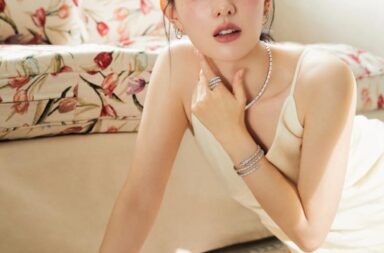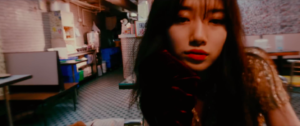
As a visual medium, K-pop generally has an affinity for sharp, eye-catching visuals and evocative storytelling. More often than not, it is known for its particular stylistic choices and aesthetics that differentiate it from the Western music industry, although each choice and aesthetic differs from one K-pop MV to the next. For an industry that touts its visuals, not only of its artists but of the filmatic musical moments that feature them, it is no surprise that any K-pop MV, no matter which specific genre or artist it belongs to, borders on being some type of cinema in its own right.
At the same time, as with any visual mode of expression, that cinematic quality doesn’t just appear from thin air. As with the actual music, melodies, and tunes that make up K-pop, which find their inspiration from music from all over the globe, its MVs do too, turning the Hallyu wave as represented by music videos into a complex tapestry of international visual references on top of those that are already purely Korean.
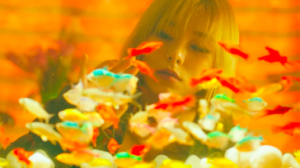
As K-pop goes through its phases of adhering to the stylistic choices of different sources of inspiration from around the world, pieces of its vast patchwork stick out more than others. Right now, that prominent piece is arguably its affinity for the aesthetics and elements of Hong Kong filmmaker Wong Kar-wai’s small but mighty cinematic universe.
K-pop is having (and has been having) a Wong Kar-wai moment. Search “Wong Kar-wai” and “K-pop” in any order together on Twitter, K-pop stans’ and netizens’ usual platform of choice, and out will come a slew of results from just this past year or even past few months alone touting even the shortest of K-pop MV clips (sometimes from just a teaser) as having a “Wong Kar-wai aesthetic.” While some of these comparisons tend to be a stretch, most of them are not far off base.
Given Wong’s status as one of the most beloved foreign filmmakers in South Korea, it is no surprise that his signature style of storytelling, signified by deeply saturated colors to emphasize mood and emotion, slow motion imagery, and tight and experimental framing, as well as more abstract themes of loneliness and longing represented through these elements, have seeped into today’s K-pop visuals.
Between lighting and color palettes, as well as production design and costuming, several MV releases from just this year alone, including Seventeen’s Wonwoo‘s and Mingyu‘s duo debut with “Bittersweet,” Even Of Day’s (Day6) “Right Through Me” MV, and TXT’s “0X1=LOVESONG,” have taken a page from the famous Hong Kong auteur’s films, not only visually, but thematically too.
These three MVs aren’t the only ones to get on the Wong Kar-wai (Chungking) Express. Suzy‘s solo debut “Yes or No” and Mamamoo‘s “Wind flower” MVs take notorious inspiration from and pay homage to Wong’s movies, including Chungking Express, In the Mood for Love, Fallen Angels, and Happy Together.
Before jumping into the trend of emulating Wong Kar-wai’s special style in action, it is first worth noting what the director’s signature style even looks like, which is unmistakable and unmissable upon first sight. Although his bench of films runs only seven deep, they are characterized by their ambiguous narratives and abstract portrayal of time, which lends to a sense of confusion shrouded in romanticism of life, love, and loneliness. Rich and saturated colors (i.e. warm reds, yellows, and greens, or cooler blues, purples, and greens) are especially used to match and evoke the mood and emotion of a scene and its characters. Wong is also known for portraying nighttime and night life in 1990s Hong Kong, showcasing its bright lights and busy streets or barren alleyways, as is most notable in his 1994 film Chungking Express.
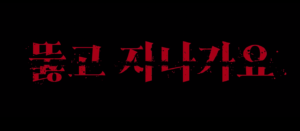
Other signature Wong cinematic elements include slow motion scenes, created by a step printing technique, and a general changing back and forth between speeds at which the film is played. On top of that, Wong also often uses tight close-ups on one character, or a frame-within-a-frame framing technique, to vividly depict the complex emotions (and oftentimes the daze or melancholy) of the characters in his films. With all of these cinematic ingredients combined, plus other common visual motifs like rain, the visuals in Wong’s films often translate to themes of loneliness, longing, and love, all with a pang of romanticism.
Even Of Day’s ”Right Through Me” MV, released this year, incorporates all of the aforementioned elements of Wong’s style to a tee. Right off the bat, the title card shown at the beginning of the MV appears in almost the same style and font as that in Wong’s romantic drama, In the Mood for Love. The film follows two lonely spouses, each married to different people, who bond after discovering that their own spouses are having an affair with each other.
This connection between “Right Through Me” and In the Mood for Love as first only indicated by the MV’s title card makes a lot of sense — “Right Through Me” lyrically and thematically follows a similar tone to In the Mood for Love, referencing feelings of longing, loss of love, and loneliness.
Aside from its lyrics, however, the MV’s visual elements and scenes, in terms of the visual elements and scenes, take clear inspiration from visual moments in Wong’s films and overall aesthetic and style. For example, the MV’s color palette is largely comprised of saturated colors, mostly seen in the overall lighting and sets the members are placed in each scene. During scenes where the members sing about falling or being in love, the background they are situated in features a predominantly deep red hue. On the other hand, during scenes depicting a departing lover or parts of the track’s lyrics discussing their love leaving them, the overall color of the scene is made up of a collection of cool, almost cold, saturated blues and greens.
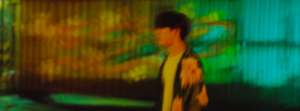
In this case, as in Wong Kar-wai’s movies, the overall color palette that saturates the scene is meant to emulate the meaning of the song’s lyrics even further in order to heighten the sense of emotion that is meant to follow. Similarly, the MV uses another classic Wong device, rain, to create a sense of confusion and heighten the sense of longing and mixed bag of emotions that “Right Through Me” seeks to convey.
The MV also frequently uses Wong’s signature step printing technique to transform blips of scenes into frantic, blurry, slowed down moments. The step printing technique is also used in one particular scene in the MV when Dowoon runs from umbrella to umbrella, searching for someone he lost — making a clear callback to Chungking Express.
Inspiration from Chungking Express, perhaps Wong’s most well-known film and the film that sprung him to stardom, also makes itself known in “Bittersweet,” the duo debut from Seventeen’s Wonwoo and Mingyu (featuring Lee Hi). The track explores the dilemma between romantic love and friendship, leaning heavily into the classic Wong Kar-wai theme of longing. While the MV’s Chungking Express-ness is undeniable from the moment it begins, it hardly comes as a surprise, as Wonwoo and Mingyu both watched the film as inspiration before filming their own MV.
“Bittersweet,” whose name already indicates an idea that is very Wong Kar-wai by nature, is littered with every iconic element that signifies clear inspiration from the filmmaker’s particular stylistic choices. From slow motion scenes, to the avid use of saturated colors and lighting, to longing gazes between characters in conspicuously-framed shots, the adherence to Wong’s way of storytelling is unmissable. Several scenes in the MV are also obvious callbacks to Chungking Express, including one scene in particular when the three in the MV run through the street, but in jaggedly pieced-together slow motion frames.
The use of color in several particular scenes also makes for other clear parallels to the visuals in the film. The scene where Wonwoo rests his head on his arms in the bar, staring off solemnly, utilizes the same iconic bright red and green lighting and hues, with the lights illuminating Wonwoo and the background of the shot from beneath the bar, just as in Chungking Express. Other outdoor shots, all of which take place at night, are also reminiscent of Wong’s films, which often feature warm golden street lamp lighting to illuminate the subjects of the scene.
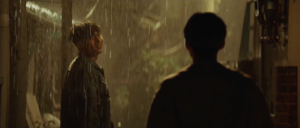
Rain is another big player in the “Bittersweet” MV, not only visually but auditorily too. As in many of Wong’s films, vivid noises, like vivid visuals, also play a key role in heightening the mood and emotion of a scene. Like in the famous rain scene in In the Mood for Love, during the final scene of the MV, the sound of rain is added over the track to add to the scene’s emotions. As Mingyu and Wonwoo stare at each other while standing under an overhang with longing gazes, the rain patters over the lingering instrumentals of the song, amplifying the emotions portrayed in their wistful stares.
Other MVs from recent years also portray the same level of affinity for Wong’s style, if not even more. TXT’s teaser for the “0X1=LOVESONG” MV features a near recreation of a scene straight out of Wong’s film Days of Being Wild. In the scene, Yeonjun performs a mambo dance, alone in front of his mirror, in the same cadence and to the same song as Leslie Cheung dances to in the film. The full MV for “0X1=LOVESONG” also includes a parallel to Chungking Express, in the shot where Yeonjun is seated behind a fish tank filled with gold fish.
2021 wasn’t the only year for this trend either. MVs like Suzy’s “Yes No Maybe” and Mamamoo’s “Wind flower” were clear trailblazers in the Wong Kar-wai category, not only taking inspiration from his signature style but more so existing as almost pure homages to the filmmaker himself.
“Yes No Maybe” is a cinematic masterpiece of its own, perhaps even a mini Wong movie in its own right. The song’s MV, also Suzy’s solo debut, features a title card in the style of In the Mood for Love at the very beginning. It then follows with a shot of Suzy standing on the roof of a building in none other than Hong Kong itself, unmistakable by the sight of the tall, crowded buildings that make up the cityscape behind her. In true Wong fashion, Suzy is framed within a frame, with the edge of the building she stands on separating her from the tall buildings in focus behind her. The MV continues with shots that mimic scenes and motifs from both Chungking Express and Fallen Angels, plus close-up and blurred, slow-motion shots taken from similar angles as in Wong’s movies.
If Suzy’s “Yes No Maybe” MV was K-pop’s original tribute to Wong Kar-wai, Mamamoo’s “Wind flower” MV is the next-gen version of that tribute, featuring shot-by-shot recreations of scenes from nearly all of Wong’s movies, including 2046. The parallels are nuanced and detailed — on top of the more obviously-Wong visual effects like heavily saturated colors and blurred filmatic sequences, the costumes, hair, makeup, props, and setting are made to look nearly identical to those in Wong’s movies.
While Wong’s style and aesthetic are generally much different from that of most K-pop MVs today and of years’ past, the choice to emulate these aesthetics and visuals isn’t that much of a stretch. K-pop, as with any industry or art form, falls into trends, and it is not inherently unique or original. With its already-proven affinity for sharp, eye-catching visuals, and cinematic touches in its MVs, K-pop’s Wong Kar-wai phase is just another step in its journey to improve upon its storytelling methods and expand upon the many pieces that make up its internationally-inspired, global puzzle.
Between the hyper-specific saturated, moody colors blurred film sequences, and melancholy visual motifs, plus the hyper-localized depiction of 1990s Hong Kong, this just happens to be Wong Kar-wai’s world — and K-pop is living in it.
(Twitter, Youtube [1][2][3][4]. Images via Pledis Entertainment, JYP Entertainment, RBW)


